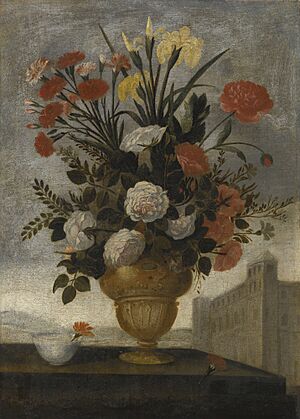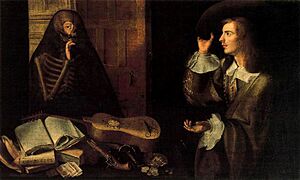Pedro de Camprobín facts for kids
Pedro de Camprobín Passano was a Spanish painter who lived in the 1600s. He was born in Almagro, Ciudad Real in 1605 and passed away in Seville in 1674. He was especially known for his beautiful still-life paintings, which often featured flowers. Still-life art shows objects that don't move, like fruit, flowers, or everyday items.
Contents
Life and Work
Early Life and Training
Pedro's father, also named Pedro, worked as a silversmith. His mother, Juana, came from a family of painters from Genoa, Italy. These painters had helped create frescoes, which are paintings done on wet plaster walls, at a place called the Palacio del Marqués de Santa Cruz.
When Pedro was about 14 years old, he started learning how to paint from a famous artist named Luis Tristán in Toledo. We don't know much about his life for a few years after that. However, in 1630, he passed an important test to become a painter in Seville. Many people believe he finished his training in Madrid with another artist named Juan van der Hamen. This is because his early paintings look similar to Hamen's style.
Artistic Style and Famous Works
From 1632 to 1634, Pedro painted a religious artwork called "Magdalena Repentant." This is the only religious painting he is known to have made. In this painting, the people look a bit like those painted by Francisco de Zurbarán. But you can also see his talent for still-life art in the objects arranged on a table. These objects are painted in a style called "vanitas," which means they remind us that life is short and things don't last forever.
Pedro married and had two daughters. He was already a widower when he wrote his will in 1670. About ten years earlier, he joined other famous artists like Bartolomé Esteban Murillo and Juan de Valdés Leal to create a drawing academy in Seville. He continued to work with this academy until he passed away.
Specialty in Floral Paintings
Even though Pedro painted many different kinds of still-lifes, he was truly best at painting flowers. He always showed them in bowls or vases, looking natural and sometimes with small creatures like butterflies nearby. Some of his flower paintings even had architectural backgrounds, similar to paintings from Italy at that time.
Pedro is also believed to have painted "Death and the Knight." This painting is at the Hospital de la Caridad. People think he painted it because of how the everyday objects are arranged and what they symbolize in the painting.
See also
 In Spanish: Pedro de Camprobín para niños
In Spanish: Pedro de Camprobín para niños



